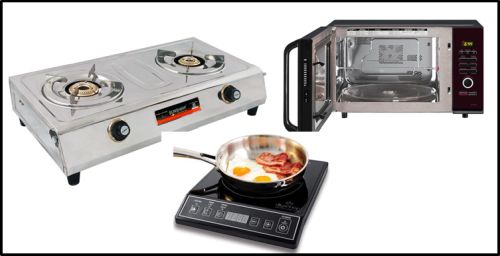Dec 15, 2025
Dec 15, 2025
Introduction
In an earlier article, I had dwelt upon the benefits of using induction cooktops in the place of gas stoves in kitchens. See https://www.boloji.com/blog/1454/induction-cooking. This article will contain all the essential parts of that post. In addition, it will present an overview of the comparative merits and demerits of the three main and commonly used heat sources – Gas Stove, Induction Cooktop, and Microwave Oven. Electric coil heaters and hot plates are not covered because the aspects that apply to gas stoves are valid for them also.
Working Principles and Efficiencies
Functionally, what is common to all methods is that we apply heat to certain food items for cooking, heating, or reheating. However, there are major differences among the three methods when we talk about the manner of heat generation and transfer to the food items. In a gas stove, the heat is generated outside the vessel, that is in the burner. In an induction cooktop, the heat is generated in the bottom part of the vessel by way of magnetic induction. Heat is thus generated only over the portion of the vessel which is in contact. Because of this reason, it is obvious that the induction cooktop will be more efficient than the gas stove. Finally, in the case o microwave ovens the heat gets generated in the food being heated. The food gets heated by getting exposed to electromagnetic radiation in the microwave frequency range. The radiation induces the polar molecules to vibrate and produce thermal energy in food of high moisture content. Then vessels, normally non-metallic, do not get heated in the process as the microwaves pass through the container walls. Thus it is easy to visualize that microwave ovens can be even more efficient than induction. Cooking in a microwave oven turns out to be even faster because the water molecules attain temperatures of 120 degrees Celsius which is comparable to the temperatures inside pressure cookers.

Uses and Limitations
GAS STOVES: In India, we won’t find any kitchen without an LPG gas heating source. They are convenient to use and have no pronounced demerits. As far as items to be cooked are concerned, there are practically no limitations. A shortcoming is that most of the gas stoves available in markets come without timers. Otherwise, a kitchen with gas stove installation can be considered to be self-sufficient.
INDUCTION: A major limitation concerning the induction cooktop is that the vessel material needs to be magnetic because of the principle of operation. We cannot use aluminum and copper bottom utensils. Additionally, the vessels need to have flat bottoms. Consequently, the induction is unsuitable for deep frying. They are also not very apt for dry roasting. Outside these restrictive limitations, induction is far superior to gas stove cooking. The biggest advantage is the induction heaters are very compact. One can use them even in drawing rooms. An additional advantage is that they have digital controls for power, temperature, and time. Of course, we cannot forget that they are more efficient as already stated. It is also notable that the induction devices are extremely user-friendly because there is no flame and hence no radiation. It is eminently possible to have the ceiling fan on while cooking.
MICROWAVE: Microwave ovens are special purpose appliances. Mostly they are used for reheating and defrosting. They are most useful for reheating dry curries and rice-like food preparations. However, they can also be used for cooking vegetables. As already stated, the moisture content of the food item generates heat in a microwave oven. As a result, it is possible to cook vegetables in these ovens without adding water. Vegetables, particularly beans, carrots, and cabbage, that are cooked in this manner retain crispness and nutrition content better as compared to the traditional way.
Safety Aspects
Out of the three appliances, safety hazards are the maximum in the case of gas stoves. Risks are due to the presence of flame which may lead to a fire. There is also due to to the possibility of gas leakage and subsequent accidents. In general, there are not sufficient safety features as safeguards against possible mishaps.
Microwave ovens are high-power (3000 W) electrical appliances and carry all the risks normally associated with the gadgets of that category. In addition, people are warned of the likelihood of explosions taking place. It is advisable to pause for a while before taking out the contents after the heating is over. The explosions can be a result of molecular level heat generation. An additional safety concern is the possibility of the leakage of electromagnetic waves.
By far, the induction cooktops are the safest. There is no risk of electrical shocks. They are classified as Class 2 equipment and hence do not need earthing. They will not draw power unless an appropriate utensil is kept in position. The vessels too are protected from getting overheated and charred if insufficient fluid content is present.
Best Practice
All kitchens should have induction cooktops as a supplement to gas stoves which are compulsorily needed. Moreover, they should be used to the maximum extent possible. Microwave ovens are useful additions.